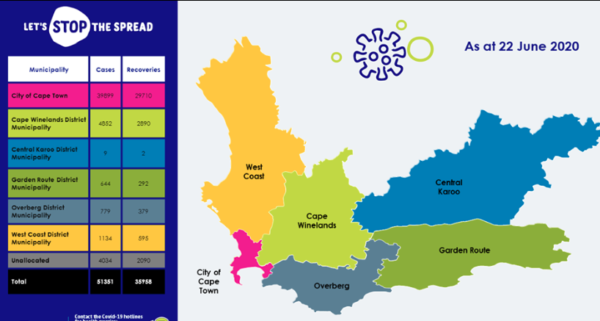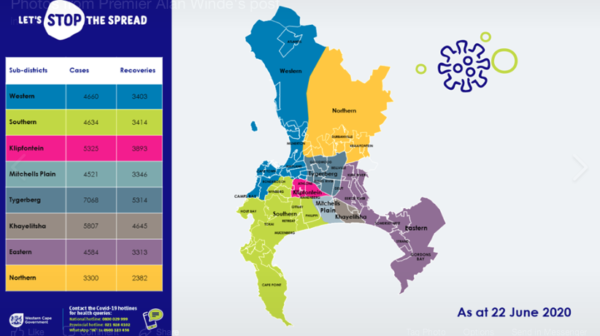The number of COVID-19 cases in the Western Cape is expected to reach its peak very soon, and as of Monday, June 22, the province has 13 969 active cases. According to Premier Alan Wide, there are 51 351 confirmed cases, and 35 958 people have recovered thus far.
“The Western Cape has recorded an additional 25 deaths, bringing the total number of COVID-19 related deaths in the province to 1424. We send our condolences to their families and friends at this time,” Winde said.
Total confirmed COVID-19 cases: 51 351
Total recoveries: 35 958
Total deaths: 1424
Total active cases (currently infected patients): 13 969
Tests conducted: 271 793
Hospitalisations: 1546 with 318 in ICU or high care
Sub Districts Cape Town Metro:
Western 4660 cases; 3403 recoveries
Southern 4634 cases; 3414 recoveries
Northern 3300 cases; 2382 recoveries
Tygerberg 7068 cases; 5314 recoveries
Eastern 4584 cases; 3313 recoveries
Klipfontein 5325 cases; 3893 recoveries
Mitchells Plain 4521 cases; 3346 recoveries
Khayelitsha 5807 cases; 4645 recoveries
Total 39899 cases; 29710 recoveries
Sub-districts:
Garden Route Bitou 34 cases; 17 recoveries
Garden Route Knysna 118 cases; 71 recoveries
Garden Route George 325 cases; 128 recoveries
Garden Route Hessequa 20 cases; 17 recoveries
Garden Route Kannaland 3 cases; 2 recoveries
Garden Route Mossel Bay 107 cases; 42 recoveries
Garden Route Oudsthoorn 37 cases; 15 recoveries
Cape Winelands Stellenbosch 808 cases; 495 recoveries
Cape Winelands Drakenstein 2131 cases; 1329 recoveries
Cape Winelands Breede Valley 1086 cases; 599 recoveries
Cape Winelands Langeberg 281 cases; 96 recoveries
Cape Winelands Witzenberg 546 cases; 371 recoveries
Overberg Overstrand 410 cases; 184 recoveries
Overberg Cape Agulhas 35 cases; 24 recoveries
Overberg Swellendam 34 cases; 16 recoveries
Overberg Theewaterskloof 300 cases;155 recoveries
West Coast Bergrivier 171 cases; 118 recoveries
West Coast Cederberg 32 cases; 11 recoveries
West Coast Matzikama 40 cases; 13 recoveries
West Coast Saldanha Bay Municipality 437 cases; 222 recoveries
West Coast Swartland 454 cases; 231 recoveries
Central Karoo Beaufort West 9 cases; 2 recoveries
Unallocated: 4034 (2090)


“As the province moves closer to the peak and the Department of Health is recording over 1000 new cases daily, it is not possible to check and verify that the address data supplied for each new case is correct, within the time frames required to provide regular and timely updates,” Winde said. “This means that in some instances, cases could be allocated to the wrong sub-districts. We are working with the sub-districts to clean and verify the data and where errors are picked up locally, cases will be re-allocated to the correct areas.”
More data is available here: https://coronavirus.westerncape.gov.za/covid-19-dashboard
“Over the weekend, thousands of posters have been put up across the metro as part of our COVID-19 awareness campaign in our hotspot areas. Posters will continue to go up in the City of Cape Town and in our non-metro regions this week,” the Premier added. “About 10 000 of these posters will be erected, forming part of the biggest public awareness campaign on record in the Western Cape. Their message in isiXhosa, English and Afrikaans is that by taking measures to keep ourselves safe such as staying at home, and wearing a mask, we are also able to protect our loved ones and family members who may be more at risk of infection.”
Active cases:
The Western Cape currently has almost 14 000 active cases of COVID-19 in the province. The term “active case” refers to a patient who is currently infected. A case is considered closed when a person has recovered, or in the event of a death.
“Recoveries significantly outnumber active cases in the province but we must still do everything we can to ensure that we are keeping safe, as those 14 000 people have the potential to infect many more people in their families and communities,” Winde added.
“As a province, we are continuously re-assessing the data available to us to give us an indication of when the virus peak will occur. These models are predictions based on the best available data at the time, and it is impossible to pinpoint exactly when this will happen but by taking additional care now, and managing the number of active cases, we can help to slow the spread and help to save lives.”
The active case management strategy has focused on:
– Screening and referral for testing of vulnerable people and households
– Screening in old aged homes
– Strengthening of telephonic follow up of positive cases and contacts system
– Referring residents to isolation and quarantine sites where self- isolation is not possible or viable
– Early identification of high-risk cases for active case management.
Members of the public can contribute to reducing active cases by:
– Staying home as much as possible to avoid becoming infected, especially if you fall into one of the risk groups
– Practicing hygiene and social distancing
– Wearing a mask
– Avoiding gatherings
– Staying home if you feel ill
– Taking up isolation and quarantine in one of our facilities if you are not able to do this at home or run the risk of infecting loved ones living with you
Businesses re-opening:
This week, a number of personal care businesses which have not been able to trade for the duration of the lockdown will begin to trade again.
“Many of these business owners and the people they employ have been significantly impacted by the lock down. Being able to trade again will help to ease the financial burden they have been suffering under, and give people the opportunity to start earning money to feed their families again,” Winde said. “While this is important for so many business owners and families across the province, we must not forget that we are still in the midst of a pandemic which has had, and will continue to have very serious consequences for many people.”
More sectors will also be coming online soon and the Premier would like to make an appeal to these businesses to always act with the best interests of their clientele and their staff at heart and abide by the restrictions and regulations put in place to ensure maximum safety.
“This means ensuring that facilities are available for hand washing or sanitizing and that surfaces are regularly cleaned to avoid your business becoming an infection site. You also need to make sure that you carefully manage the number of people on your business premises at any given time to allow for social distancing.”
Customers must also act responsibly by wearing a mask and to stay at home if they feel unwell, rather than putting people at risk when frequenting any of these businesses or services.
Picture: Polity.org






